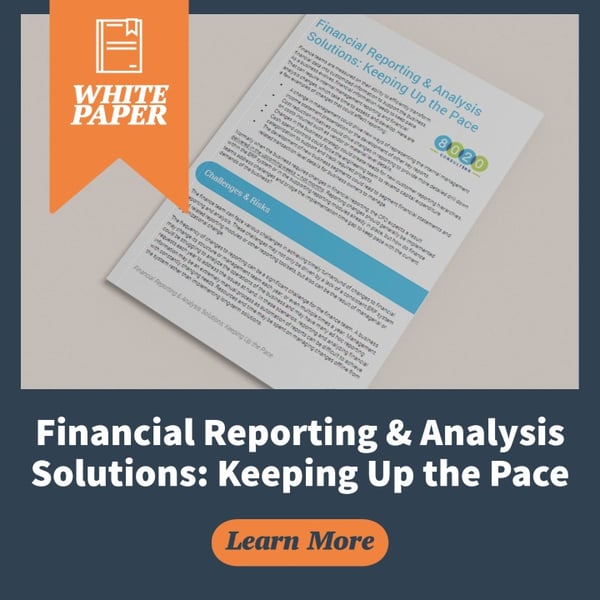
The accounting community has been discussing the new leasing standard (ASC 842) since February of 2016. If your company hasn’t already developed an implementation plan, then now is the time. The new standard takes effect for public companies with annual periods beginning after Dec. 15, 2018 and for all other entities for annual periods beginning after Dec. 15, 2019.
The standard now requires operating leases to be shown on the balance sheet rather than mentioned only in footnotes. With the exception of certain narrowly defined short-term leases, U.S. GAAP now requires all leases be recognized on a lessee’s balance sheet as a lease liability with a corresponding right-of-use (ROU) asset.
If your business doesn’t enter into many leasing contracts, then the impact to financial reporting and recordkeeping might be minimal. However, if your leasing contracts are numerous, then the existing recordkeeping and related reporting requirements can be onerous and error prone – especially if lease administration is decentralized and leasing subledgers are maintained in an Excel database.

As businesses adopt the new standard, there are some things to consider:
- The lease accounting standard will require companies to adopt new policies to ensure their financial statements are in compliance with U.S. GAAP and also make major changes to their accounting processes and practices.
- Given the requirement to present leases on the balance sheet, the process of identifying contracts that are, or contain, leases takes on a greater importance. In addition, while the income statement reporting of leases remains largely unchanged, the requirement to present operating leases on balance sheets may also introduce the need for impairment testing or other complexities.
- Many companies may find it necessary to maintain a lease accounting subledger to record all relevant journal entries. This might result in the need to maintain payment, depreciation and liability amortization schedules, including interest accretion. And these schedules will need to be modified for any changes, renewals or impairments on a regular basis.
This level of detail and complexity – combined with the volume of leases to be tracked, version control needs, and workflow approval requirements – may make it difficult for many companies to continue managing their lease portfolios using spreadsheets, which has historically been a common method. Additionally, executives may be struggling with the transition and discovering their current systems for tracking leases are completely inadequate to maintain accurate recordkeeping and reporting. Executives grappling with the new standards may also recognize the need to centralize and integrate their previously disconnected lease management practices and automate potentially outdated manual processes.
One of the first activities to be performed is to identify and create an accurate inventory of all leases. If lease management is decentralized, then proper identification of leasing contracts may be difficult, especially because leases can be embedded in contracts that may not appear to be a lease. This might include business machine service contracts for equipment, which may include computer servers, ATMs, or vending machines. Local managers may regard such agreements as service contracts when they may, in fact, contain leases for accounting purposes.
Existing resource demands on accounting departments may make it impractical to handle this initial inventory internally. Therefore, many companies are turning to consulting organizations, Artificial Intelligence (AI) and software providers to assist with the implementation.

Readiness for Implementation
The first step toward implementing the new standard is identifying the right internal or external resources to manage the implementation (i.e., the project manager). The right resource will have the knowledge and the bandwidth to devote to the implementation. Oftentimes internal staff may have competing demands and are therefore unable to devote the time needed for the project. If that is the case, a consultant who is a project manager and familiar with the subject matter would be the efficient and cost-effective option.
Once the project manager has been selected, create a project plan with a timeline for completion based on the available resources, number of leases, types of leases, and selection of technology to support the implementation. The following are major considerations of the plan:
- Define how the company will manage lease administration:
- Centralize lease administration by requiring all contracts entered into be reported to a centralized accounting function for cataloging leases in a central depository and determining whether the contract contains a lease.
- Remain in a de-centralized administration mode. However, all managers entering into leases will require education to properly identify embedded leases and be required to provide accounting staff with such leases.
- Determine whether Artificial Intelligence be used to identify leasing elements in contracts. Whether a centralized or de-centralized administration model is used, if the number of leasing contracts or potential leasing contracts is large, an AI tool will increase identification of leases and reduce reporting errors.
- Determine whether to use lease accounting software or whether to upgrade your existing software to automate the implementation and provide the necessary lease schedules and the related journal entries.
- Prepare a timeline that allows for determination and implementation of lease administration, selection of AI and accounting leasing software with completion based on the available resources, number of leases, and technology to support the implementation.
The project plan will increase visibility of the project, reduce risk of an incomplete lease inventory, reduce demands on human resources, and increase the accuracy and timeliness of reporting. Additionally, the investment in an organized approach could pay for itself.
Considering Artificial Intelligence and/or New Leasing Accounting Software
Regardless of whether the inventory of leases is small, medium or large, businesses are now at the point where they should consider dedicated contract management or lease administration software. In the longer term, companies will need to implement consistent, repeatable processes that update the accounting organization whenever any lease change occurs. To achieve this, many companies will require both lease administration and lease accounting capabilities.
Is AI software cost-effective?
This will depend on the number of leases an entity must review and maintain. With a thousand or more leases an AI software solution becomes a valuable tool, especially when the AI tool provides a 98% or higher accuracy reading. Note that with a leasing data base of less than a thousand leases the investment might also be cost effective varying with the company’s growth rate, the complexity of the leases and inhouse personnel available to manage the process.

Should a company use existing leasing software or a standalone system?
Companies might try to use their resident ERP systems (if capable) to manage all the new required reporting. They might also be better served by installing a standalone system for the accounting calculations. The answer to the following questions may provide some answers:
- Does the resident ERP system manage all the necessary output required by the new standard like maintaining the accounting-related data, recording the transactions, providing documentation for audits and financial reporting without the need for a significant amount of staff involvement?
- What are the costs of transitioning to a new contract management or lease software compared to the elimination of recurring costs associated with reporting under the new standard using the current methodology?
- Will the use of a new leasing administration software reduce reporting time?
If new lease accounting software is needed, is an established vendor or newer vendor more appropriate?
While an established vendor may possess cumulative knowledge collected over several years, newer vendors may have specifically designed their software around the new standard. Given that both types of vendors provide the necessary data, additional selection factors might include:
- Does the software align internal processes and efficient staff utilization?
- Does the software provide flexibility, scalability and web-based access that meets the future needs of the business?
The selection process for software is significant, and many companies remain undecided with the implementation date looming. According to research by national accounting firms, most finance and accounting leaders plan to finalize the design of required changes during 2018 and complete implementation by December 31, 2018. However, more than 70% of these companies do not yet have a dedicated software system able to handle the new leasing standard, even though the majority of companies surveyed opt for externally developed leasing systems.
It’s Time to Ask for Help if You Need It.
If you are one of the companies that isn’t prepared for the new leasing standard, or even if you just want a third party to confirm your strategy, contact 8020 Consulting for help. Our consultants can support you by developing a project plan, designing a lease administration policy and process, reviewing AI and lease accounting software requirements, and drive the decision-making process. We can provide a roadmap for success, and we can also support you throughout the project.
Want More Insight?
If you're interested in financial reporting and analysis solutions, then consider downloading our new whitepaper. It offers insight into keeping up the reporting pace while waiting on longer-term systems implementations:
Thanks for reading!
About the Author
Susan is a CPA with 20+ years of diverse finance and accounting experience in various industries including manufacturing, technology, apparel and real estate. She is an Ernst and Young alumnus who has held leadership roles at Fortune 500, middle market and entrepreneurial companies as Controller, VP of Finance and CFO. These companies have included Power-One, Clipper Windpower, Allied Signal, and Special Devices among others. Susan has provided financial leadership and project management to accounting organizations, including turnaround and restructuring projects, creating international tax structures, implementing IFRS, managing internal and external financial reporting, system implementation and leading finance and accounting efforts for divesture, acquisition and process re-engineering. Susan holds a BS in Accountancy from San Diego State University.
Image Credits:
- Photo by Jamie Street on Unsplash
- Photo by Alina Grubnyak on Unsplash
- Photo by Kevin Ku on Unsplash




